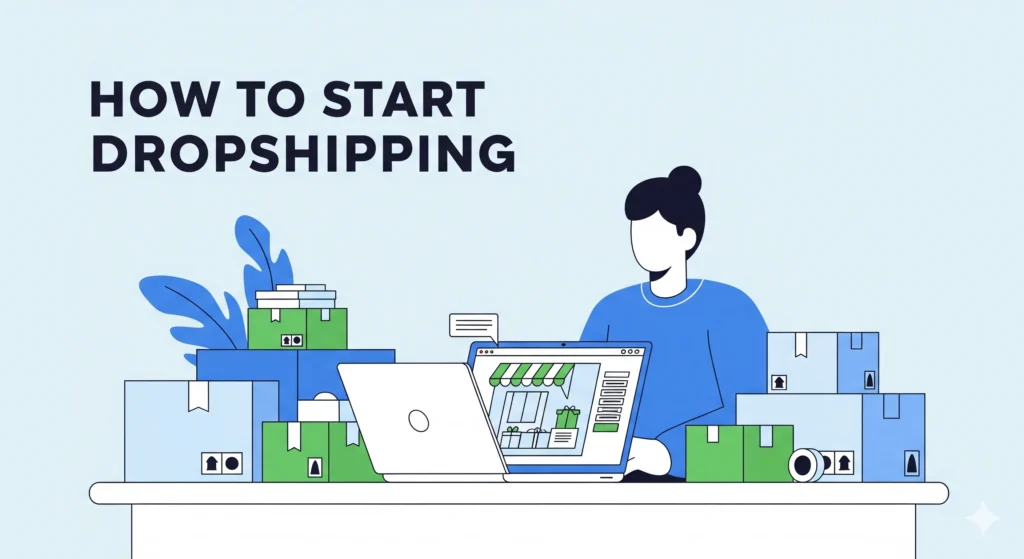If you’ve been Googling side hustles or ways to make money online, chances are dropshipping has popped up on your radar. And for good reason. The model is simple: you sell products online without actually holding inventory. The supplier ships directly to the customer, while you handle marketing and customer relationships.
Sounds easy, right? Well… yes and no. Dropshipping is accessible, but success isn’t automatic. Plenty of people give up after a few months because they treat it like a get-rich-quick scheme. The ones who make it work approach it like a real business.
Let’s break down what you need to know, step by step, without the fluff.
1. Understand What Dropshipping Really Is (and Isn’t)
At its core, dropshipping removes the headache of buying and storing products. You don’t need a warehouse or upfront inventory costs. You only pay your supplier when a customer pays you.
But here’s the catch:
-
Margins are thinner than traditional e-commerce. You’re the middle layer, so profit per sale isn’t huge.
-
You can’t control shipping speed or product quality as tightly since the supplier handles fulfillment.
-
Competition is intense. If you’re selling the exact same products as 500 other stores, you’ll need to stand out.
The good news? If you pick the right niche, build a strong brand, and know how to market, it can still be a profitable business model.
2. Pick a Niche That Actually Works
This is where most people go wrong. They either chase random trending products or copy what everyone else is selling. Instead, think about:
-
Evergreen demand: Products that people need year-round (fitness gear, kitchen tools, pet accessories).
-
Passion-driven markets: Hobbies and lifestyles where buyers don’t mind spending (gaming, outdoor sports, beauty).
-
Problem solvers: Items that make life easier (ergonomic tools, smart organizers, health gadgets).
-
Price sweet spot: Products between $20–$100 often work best. Cheap items won’t give you enough margin, and high-ticket items can make customers hesitate.
Example: Instead of selling generic yoga mats (too crowded), you could niche down into eco-friendly, cork-based yoga gear that speaks to conscious buyers.
3. Research Suppliers Carefully
Suppliers are the backbone of dropshipping. A bad one can ruin your business fast. Don’t just grab the first name you find on AliExpress. Look at platforms like:
-
DSers (AliExpress official partner) – works with Shopify and WooCommerce.
-
CJ Dropshipping – faster shipping options, warehouses in multiple countries.
-
Spocket – focus on US/EU suppliers, so customers get quicker delivery.
-
Printful / Printify – for print-on-demand products like T-shirts, mugs, and posters.
Pro tip: Always order samples for yourself before listing products. You’ll see the real shipping times, packaging, and quality.
4. Choose the Right Platform for Your Store
Your storefront matters because it’s the only “real estate” your customers see. Here are the main options:
-
Shopify: The most popular, beginner-friendly, tons of apps and integrations. Monthly fee, but worth it for ease of use.
-
WooCommerce (WordPress): Free plugin, more customizable, but requires some technical setup.
-
BigCommerce / Wix / Squarespace: Decent alternatives, but not as widely used for dropshipping.
If you’re starting fresh, Shopify is usually the fastest way to get moving.
5. Set Up Your Online Store
This step is where many people get stuck because they overcomplicate things. Don’t aim for perfection right away—get a clean, professional store live.
-
Domain name: Short, brandable, easy to spell. Example: instead of “bestfitnessgadgetsforyou.com,” go with “FitNest.com.”
-
Theme: Keep it simple. Minimal, clean layouts work better than flashy designs.
-
Essential pages: Home, Shop, About, Contact, Shipping & Returns.
-
Trust signals: Add clear policies, customer reviews, and payment icons (Visa, PayPal, etc.).
Remember, a store that looks sketchy will kill your conversions faster than any marketing mistake.
6. Figure Out Pricing and Profit Margins
Let’s say you find a product that costs $12 from your supplier. Shipping is $3. Total = $15.
If you sell it for $39, your gross margin is $24. But don’t forget:
-
You’ll spend money on ads (Facebook, TikTok, Google).
-
Shopify or payment processors take fees (2–3%).
-
You might offer discounts or free shipping.
A safe rule: aim for a 2.5x to 3x markup over supplier cost. That gives you room to cover expenses and still make profit.
7. Market Like Your Business Depends on It (Because It Does)
The reality: even the best product won’t sell itself. Marketing is where dropshippers sink or swim.
Some proven approaches:
-
Paid ads: Facebook and TikTok are goldmines if you know targeting. Start small, test creatives, scale winners.
-
Organic TikTok / Instagram Reels: Short videos of your product solving a problem or in action can go viral for free.
-
Google Shopping Ads: Works well if your product has search demand.
-
Influencer shoutouts: Micro-influencers (5k–50k followers) often drive better ROI than huge accounts.
Pro tip: Instead of just showing the product, show the transformation. A “before and after” video or a “problem → solution” clip will outperform a plain product demo.
8. Handle Customer Service Like a Pro
Dropshipping often gets a bad rep because of poor customer support. Don’t fall into that trap.
-
Be transparent about shipping times on your site. Don’t promise 3–5 days if it’s really 10–15.
-
Respond quickly. Even a polite reply saying “we’re checking with the supplier” is better than silence.
-
Offer easy refunds/returns. Yes, you’ll lose money on some orders, but you’ll gain trust (and repeat customers).
Think long-term. One satisfied buyer can bring in five referrals. One angry customer can destroy your reputation with a single post.
9. Track, Test, Improve
No successful dropshipper just “sets and forgets.” You need to constantly track performance and adapt.
-
Which ads bring the best ROI?
-
Which products get clicks but no sales (bad product or bad page)?
-
What’s your average customer acquisition cost (CAC) compared to lifetime value (LTV)?
Tools like Google Analytics, Shopify dashboard, and Facebook Ads Manager are your best friends.
10. Be Ready for Challenges
Dropshipping can be exciting, but let’s keep it real. Here’s what you should expect:
-
Refund requests: They’ll happen. Build them into your budget.
-
Supplier issues: Sometimes stock runs out, sometimes shipping delays happen. Always have backup suppliers.
-
Ad fatigue: That TikTok ad that crushed it last week might flop next week. Keep testing.
-
Competition: Anyone can copy a winning product. That’s why branding, customer experience, and unique positioning matter.
The people who succeed aren’t the ones with the best idea—they’re the ones who stick through the learning curve.
Frequently Asked Questions
1. Do I need a lot of money to start?
Not really. A basic Shopify plan + domain + initial ad spend ($200–$500) can get you started. Scaling requires reinvesting profits.
2. Is dropshipping legal?
Yes, absolutely. As long as you’re paying taxes and following consumer protection laws, you’re fine.
3. Can I dropship on Amazon?
Technically yes, but Amazon has strict rules. Most beginners start with Shopify because it gives more control.
4. How long until I see results?
It depends on your marketing and product choice. Some hit profits in weeks, others take months. Patience is key.
Final Thoughts
Starting a dropshipping business isn’t rocket science, but it’s not magic either. You don’t need to be a coding genius or a millionaire. What you do need is consistency, patience, and a willingness to test and learn.
Think of it less as “easy money” and more as a low-barrier entry into entrepreneurship. If you approach it with the right mindset, it can teach you valuable skills in marketing, customer service, and running an online business.
The sooner you start experimenting, the sooner you’ll figure out what works for you. And that’s the real secret—execution beats endless research every single time.



